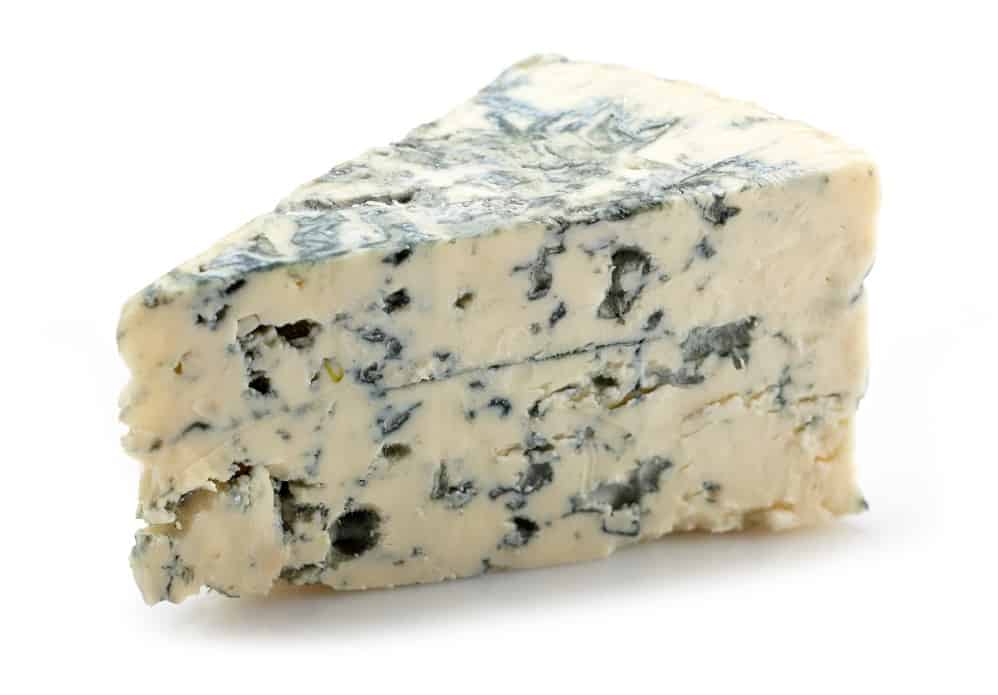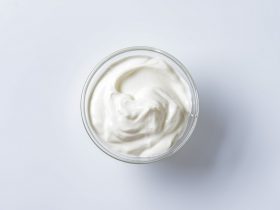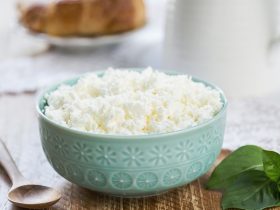There is growing concern regarding the consumption of cheese during pregnancy, as some types of cheese have been constantly linked to food borne infections, especially Listeriosis. With a huge variety and different kinds of cheeses, it can be hard to keep up as to which ones are safe to eat.
Blue cheese has been implicated in a number of outbreaks associated with Listeriosis infections. Because of this, CDC has recommended against its consumption for all high-risk population groups, including pregnant women. However, blue cheese made from pasteurized milk and thoroughly cooked dishes with blue cheese can be safely consumed during pregnancy.
What is Blue Cheese?

Blue cheese is a mold-ripened cheese that is generally made with unpasteurized milk. It is also sometimes called “bleu cheese” or “blue-veined cheese.”
It is known for its blue shade, intense smell and distinctive flavor. It is a regular ingredient in salad dressings and sauces, and may also be served with fruits, nuts and other kinds of cheese. Some of the most famous varieties of blue cheese are French Roquefort, English Stilton, Spanish Cabrales, Danish Danablue or Italian Gorgonzola (Ropars et al., 2017).
How is Blue Cheese Made?
According to the U.S. Food and Drug Administration (US FDA, 2020), blue cheese is “characterized by the presence of bluish-green mold, Penicillium roqueforti, throughout the cheese.” Penicillium roqueforti is a fungus used as a starter culture to make blue cheeses worldwide. It is responsible for the flavor and color of blue cheese (Gillot et al., 2015), as well as the distinguishing blue and green veins and spots (Ropars et al., 2017).
Specific requirements for blue cheese set forth by the US FDA (2020) include the following:
- Minimum milkfat content is 50 percent by weight of the solids
- Maximum moisture content is 46 percent by weight
- Dairy ingredients used (milk, nonfat milk, cream) may be pasteurized
- Rennet or other clotting enzymes are added to set the ingredients into a semisolid mass
- Blue cheese is at least 60 days old
- Each ingredient used should be declared on the label
The strains of Penicillium used to produce blue cheese do not produce patulin, a mycotoxin that is harmful to humans, and are considered safe to eat (Ogawa et al., 2014). At the start of the process of cheesemaking, Penicillium is added into the cheese curds (Ropars et al., 2017) while they are being drained and rolled into wheels.
After sufficient drainage, the shaped curd is salted with dry salt or brine. Perforations are made in the curd and held at temperature of about 50 degrees Fahrenheit at 90 to 95 percent relative humidity for the characteristic mold growth to develop (US FDA, 2020). The blue cheese is then aged for up to 3 months before it becomes ready for consumption.
What are the Benefits of Eating Blue Cheese?
Cow’s milk and dairy products are major sources of calcium, phosphorus, choline, riboflavin, and vitamins B12 and A. In the United States, dairy products provide around 72% of calcium needs (Facioni et al., 2020).
Blue cheese contains high concentrations of Andrastins A, B, C and D, metabolites of Penicillium roqueforti. They are potent inhibitors of farnesyltransferase, which is a major enzyme in the biosynthesis of cholesterol (Visioli & Strata, 2014).
Andrastin A also exhibits strong anti-tumor properties (Nielsen et al., 2005). Yasuda et al. in 2010 demonstrated that blue cheese was capable of suppressing cell growth, as well as inducing apoptosis in DNA-damaged cells and nucleic morphological change, in human leukemic cells.
Other reported health benefits of consuming blue cheese are:
- Reduced risk of osteoporosis
- Prevention of obesity
- Decreased risk of cardiovascular disease
Listeriosis from Consumption of Blue Cheese
Majority of blue cheeses are made using unpasteurized milk. Unpasteurized dairy products are at high risk for contamination with Listeria monocytogenes. As reported by Jackson et al. in 2018, a survey of different soft cheeses (Latin-style, blue cheese, mold-ripened) confirmed the presence of Listeria in 1.3 percent of those made from unpasteurized milk or are unlabeled, and 0.5 percent of those made from pasteurized milk.
L. monocytogenes causes the food borne disease Listeriosis. This bacterium can grow at refrigerator temperatures of 4 to 10 degrees Celsius. Even freezing has little damaging effect on this microbe (Bortolussi, 2008).
On the other hand, the process of pasteurization effectively kills Listeria. However, failure to attain the required temperature in large packages can allow this organism to survive. Moreover, cheeses can be contaminated after milk pasteurization by the introduction of unpasteurized ingredients during its processing (Bortolussi, 2008).
Listeriosis is a rare illness, but is 20 times more common in pregnant women compared to the general population (Choi et al., 2016). Listeriosis can present as fever, body pains, stomach upset and headaches. Symptoms are often mild and the disease may not even be recognized. Nevertheless, L. monocytogenes can cross the placenta and can lead to severe disease or fetal demise (Janakiraman, 2008). It can result in miscarriage, premature birth, maternal and neonatal sepsis, and infant death (Moran et al., 2018).
More serious symptoms in pregnant women include stiff neck, confusion, convulsions and loss of balance (Janakiraman, 2008). These may be signs that Listeria has entered the central nervous system (CNS), where it can cause the following (Disson & Lecuit, 2012):
- Bacterial meningitis – inflammation of fluid and meninges around the brain and spinal cord
- Meningoencephalitis – inflammation of brain and meninges
- Rhombencephalitis – inflammation of brainstem and cerebellum
How to Prevent Listeriosis Infection
Any blue cheese that made use of raw milk should be avoided during pregnancy. As recommended by the Centers for Disease Control and Prevention (CDC), all pregnant women should not eat soft cheeses (feta, brie, camembert), blue-veined cheeses, or Mexican-style cheeses (queso blanco, queso fresco, Panela) that were made from unpasteurized milk (Lamont et al., 2011).
This includes blue cheese dressings, which often combines blue cheese with mayonnaise and other ingredients that may not have undergone pasteurization. Therefore, these should be avoided by pregnant women as well.
Then again, some blue cheeses are made from pasteurized milk. Pregnant women can look at the product label to check. These can be safely consumed during pregnancy as pasteurized dairy products are safer from Listeria contamination.
In addition, cooking is another way to kill the pathogen L. monocytogenes. Because of this, fully cooked dishes that used blue cheese as an ingredient are safe to eat during pregnancy.
According to the NHS (2020), types of cheese that are safe for pregnant women to consume include:
- Pasteurized hard cheeses – cheddar, Stilton, parmesan
- Pasteurized soft cheeses – cottage cheese, mozzarella, feta, cream cheese, paneer, ricotta, halloumi, goat’s cheese without rind, processed cheese spreads
- Thoroughly cooked unpasteurized soft cheeses, until steaming hot
- Thoroughly cooked soft cheeses with rind, until steaming hot
- Thoroughly cooked blue cheeses, until steaming hot
- Pasteurized milk, yogurt, cream, ice cream
Meanwhile, the following cheeses are advised to be avoided during pregnancy (NHS, 2020) to avoid Listeriosis infection:
- Mold-ripened soft cheeses with rind – brie, camembert, chèvre (unless cooked until steaming hot)
- Blue cheeses – danish blue, gorgonzola, Roquefort (unless cooked until steaming hot)
- Any unpasteurized cow’s, goat’s or sheep’s milk
- Any food made from unpasteurized milk – like mayonnaise
Final Thoughts
Blue cheese is a soft cheese that is ripened with the mold Penicillium roqueforti. It is more often made with unpasteurized milk, putting it at high risk of being contaminated with Listeria monocytogenes and causing the infection Listeriosis.
Listeriosis can be a dangerous infection in pregnant women and can lead to fetal or infant death. Therefore, blue cheese and all products that contain it as an ingredient should be avoided during pregnancy.
Still, some blue cheeses are made with pasteurized milk. The process of pasteurization kills L. monocytogenes. Likewise, thorough cooking can render blue cheese safe to eat. Hence, blue cheese made from pasteurized milk, as well as cooked dishes with blue cheese, can be safely consumed during pregnancy.
It is good advice for pregnant women to be cautious about eating different types of cheese. In the same way, checking product labels before purchasing is a good practice during pregnancy. Talking to a doctor or specialist is the best way to alleviate pregnant women’s concerns about food consumption.
References
- https://www.healthline.com/nutrition/is-blue-cheese-mold
- https://www.webmd.com/diet/health-benefits-blue-cheese
- https://www.nhs.uk/pregnancy/keeping-well/foods-to-avoid/
- https://www.webmd.com/baby/news/20031105/pasteurized-soft-cheese-ok-in-pregnancy
- Bortolussi, R. (2008). Listeriosis: A primer. Canadian Medical Association Journal 179(8), 795-797. doi: 10.1503/cmaj.081377
- Choi, K., Lee, H., Lee, S., Kim, S., & Yoon, Y. (2016). Cheese microbial risk assessments: A review. Asian-Australasian Journal of Animal Sciences 29(3), 307-314. doi: 10.5713/ajas.15.0332
- Disson, O., & Lecuit, M. (2012). Targeting of the central nervous system by Listeria monocytogenes. Virulence 3(2), 213-221. doi: 10.4161/viru.19586
- Facioni, M. S., Raspini, B., Pivari, F., Dogliotti, E., & Cena, H. (2020). Nutritional management of lactose intolerance: The importance of diet and food labelling. Journal of Translational Medicine 18, 260. doi: 10.1186/s12967-020-02429-2
- Gillot, G., Jany, J., Coton, M., Le Floch, G., Debaets, S., Ropars, J., …, & Coton, E. (2015). Insights into Penicillium roqueforti morphological and genetic diversity. PLoS One 10(6), e0129849. doi: 10.1371/journal.pone.0129849
- Jackson, K., Gould, L. H., Hunter, J., Kucerova, Z., & Jackson, B. (2018). Listeriosis outbreaks associated with soft cheeses, United States, 1998-2014. Emerging Infectious Diseases 24(6), 1116-1118. doi: 10.3201/eid2406.171051Janakiraman, V. (2008). Listeriosis in pregnancy: Diagnosis, treatment, and prevention. Reviews in Obstetrics & Gynecology 1(4), 179-185. https://www.ncbi.nlm.nih.gov/pmc/articles/PMC2621056/
- Lamont, R., Sobel, J., Mazaki-Tovi, S., Kusanovic, J. P., Vaisbuch, E., Kim, S. K., …, & Romero, R. (2011). Listeriosis in human pregnancy: A systematic review. Journal of Perinatal Medicine 39(3), 227-236. doi: 10.1515/JPM.2011.035
- Moran, L. J., Verwiel, Y., Khomami, M., Roseboom, T. J., & Painter, R. C. (2018). Nutrition and listeriosis during pregnancy: A systematic review. Journal of Nutritional Science 7, e25. doi: 10.1017/jns.2018.16
- NHS. (2020). Foods to avoid in pregnancy. https://www.nhs.uk/pregnancy/keeping-well/foods-to-avoid/
- Nielsen, K. F., Dalsgaard, P. W., Smedsgaard, J., & Larsen, T. O. (2005). Adrastins A-D, Penicillium roqueforti metabolites consistently produced in blue-mold-ripened cheese. Journal of Agricultural and Food Chemistry 53(8), 2908-2913. doi: 10.1021/jf047983u
- Ogawa, Y., Hirose, D., Akiyama, A., & Ichinoe, M. (2014). Examination of the taxonomic position of Penicillium strains used in blue cheese production based on the partial sequence of β-tubulin. Shokuhin Eiseigaku Zasshi 55(3), 157-161. DOI: 10.3358/shokueishi.55.157
- Ropars, J., Lopez-Villavicencio, M., Snirc, A., Lacoste, S., & Giraud, T. (2017). Blue cheese-making has shaped the population genetic structure of the mould Penicillium roqueforti. PLoS One 12(3), e0171387. doi: 10.1371/journal.pone.0171387
- U.S. Food & Drug Administration. (2020). CFR: Code of federal regulations Title 21. https://www.accessdata.fda.gov/scripts/cdrh/cfdocs/cfcfr/CFRSearch.cfm?fr=133.106
- Visioli, F., & Strata, A. (2014). Milk, dairy products, and their functional effects in humans: A narrative review of recent evidence. Advances in Nutrition 5(2), 131-143. doi: 10.3945/an.113.005025
- Yasuda, S., Ohkura, N., Suzuki, K., Yamasaki, M., Nishiyama, K., Kobayashi, H., …, & Igoshi, K. (2010). Effects of highly ripened cheeses on HL-60 human leukemia cells: Antiproliferative activity and induction of apoptotic DNA damage. Journal of Dairy Science 93(4), 1393-1400. doi: 10.3168/jds.2009-2696




